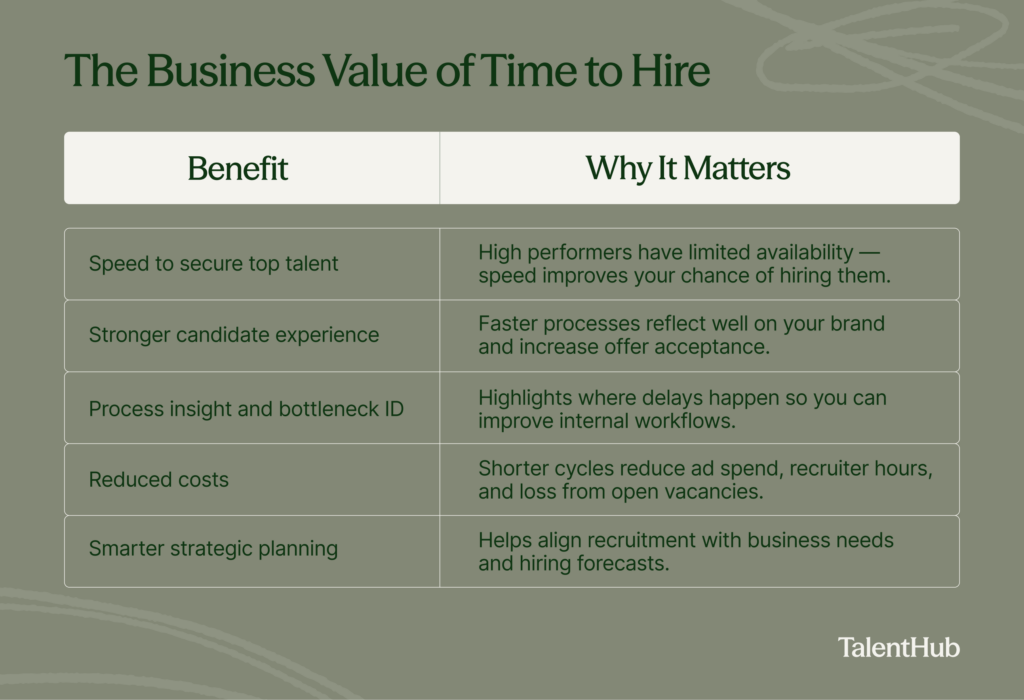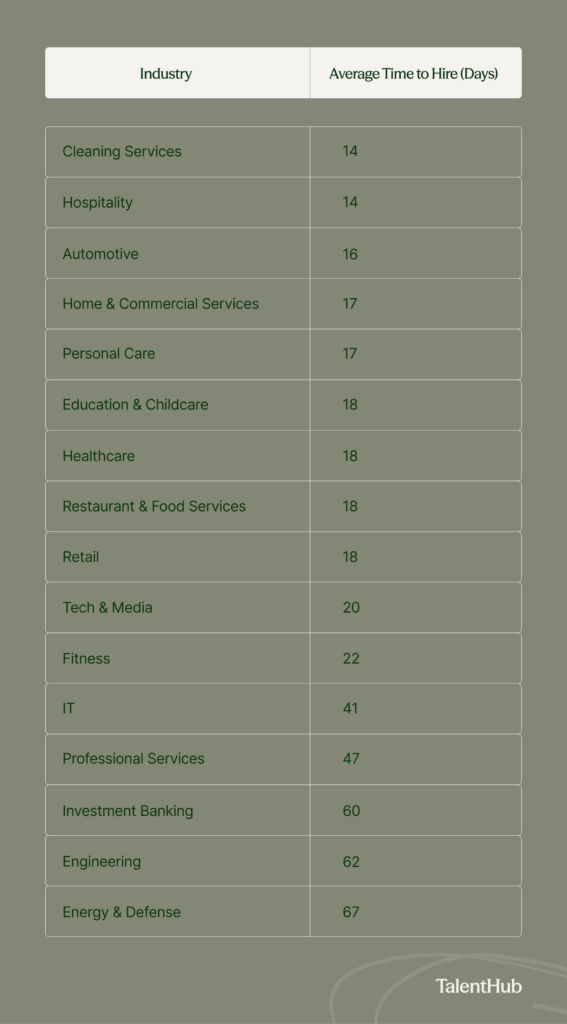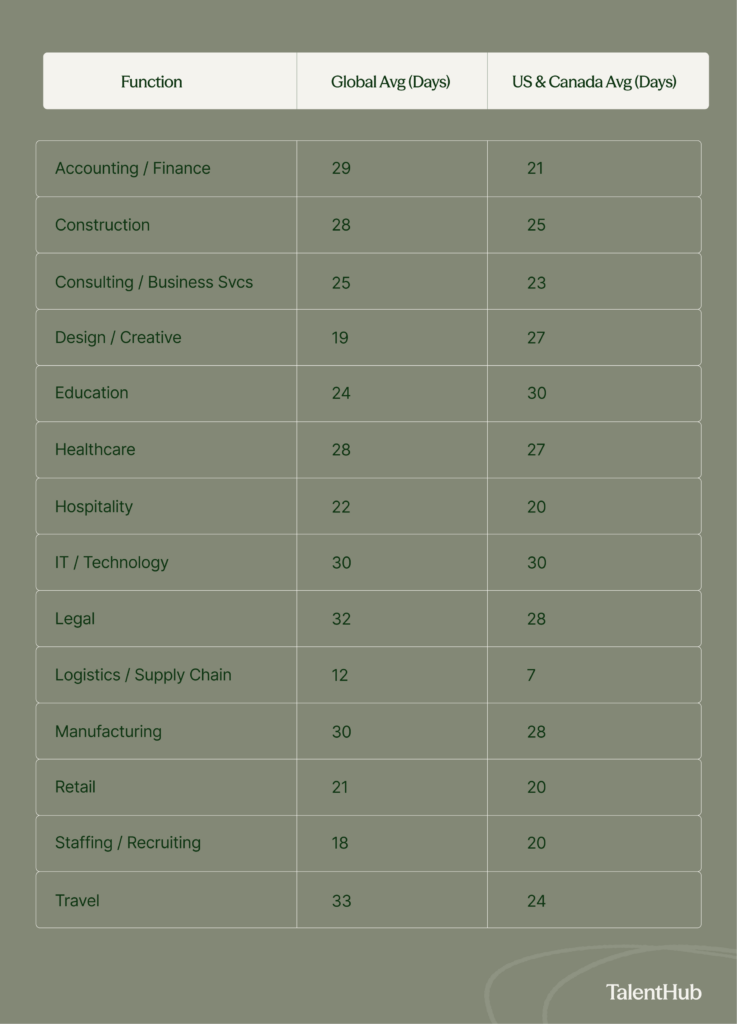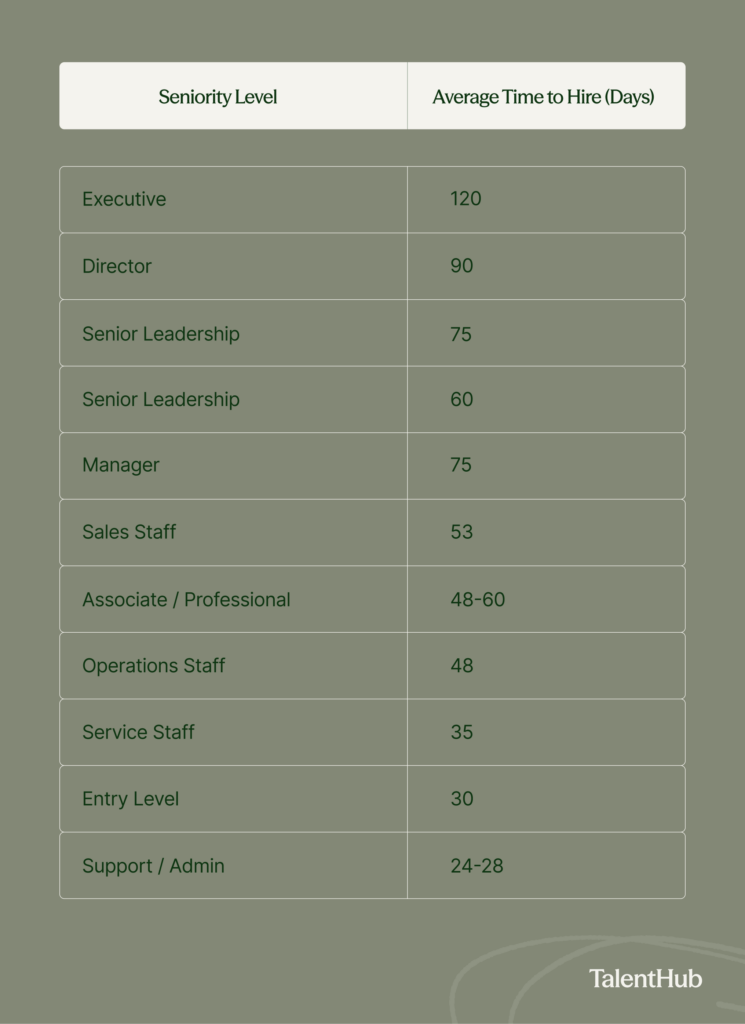Top candidates are typically off the market within 10 days, yet the global average time to hire now hovers around 44 days.
That gap poses a serious risk. Not just in terms of losing talent to faster-moving competitors, but also in higher recruitment costs, delayed projects, and team burnout. Time to hire is a key recruiting metric that reflects how efficiently an organization moves a candidate from pipeline entry to offer acceptance.
In this article we’ll explore what time to hire is, why it’s critical to track, global benchmarks by industry and role, and proven strategies to reduce it.
What is Time to Hire?
Time to hire is a recruiting metric that measures the number of days between the moment a candidate enters the hiring process (typically by applying, being sourced, or referred) and the moment they accept a job offer.
It reflects how quickly a company identifies, evaluates, and secures the right candidate after they’ve entered the recruitment funnel.
What’s the difference between time to fill and time to hire? Time to fill measures the number of days from when a job is posted to when an offer is accepted, while time to hire measures the days from when a candidate enters the pipeline to when they accept the offer.
Why is Time to Hire Important to Track?
Time to hire is one of the most valuable and actionable recruitment metrics in modern talent acquisition.
Here’s why tracking it matters:
1. It Measures Recruitment Efficiency
Time to hire reveals how quickly your recruitment process moves once the right candidate is engaged. It shows how effective your hiring team is at:
- Spotting qualified candidates early
- Moving applicants through interviews and assessments
- Making fast, informed decisions
A long time to hire often signals unnecessary delays — such as slow interview scheduling, feedback bottlenecks, or overcomplicated approval chains.
If one department consistently has a slower time to hire, you can analyze its recruitment stages to identify specific inefficiencies.
2. It Impacts the Candidate Experience
The hiring process is often a candidate’s first impression of your organization. Long wait times, delayed feedback, or repeated rescheduling can lead to frustration — and ultimately cause top talent to drop out:
- Over 75% of candidates associate the speed of hiring with how much an employer values them.
- 57% of job seekers lose interest if the hiring process takes too long.
A streamlined time to hire shows candidates you’re respectful of their time, decisive, and well-organized — critical for employer branding and offer acceptance.
3. It Improves Hiring Outcomes and Talent Acquisition ROI
In a competitive market, top candidates are off the market within 10 days. The faster your hiring process, the higher the chances you’ll secure your preferred candidate before they accept another offer.
A shorter time to hire also:
- Reduces the risk of losing passive or in-demand candidates
- Increases your offer acceptance rate
- Decreases overall recruitment costs (such as less ad spend or fewer lost hours)
4. It Lowers Cost-per-Hire and Reduces Vacancy Loss
Every day a position goes unfilled, productivity, morale, and revenue may take a hit. The longer it takes to hire leads to:
- A higher cost of coverage (hiring temp staff, overtime, and lost output)
- More strain placed on existing team members
- Making the recruitment process more expensive
Tracking time to hire lets you identify and eliminate delays that cause these hidden costs.
5. It Supports Strategic Workforce Planning
Time to hire helps organizations forecast how long it takes to fill roles once candidates are active in the pipeline. This supports:
- Project planning
- Seasonal hiring prep
- Agile resource allocation across departments
It also complements time to fill, which tracks from requisition to offer. Together, these metrics give you a full view of your hiring velocity from both organizational and candidate perspectives.
6. It Provides a Benchmark for Continuous Improvement
When measured consistently across departments, time to hire becomes a baseline for setting goals, testing new tools (like ATS automations), or comparing against industry benchmarks.
- Is it taking longer to hire in one location or role type?
- Did a new recruitment process or partner agency improve performance?
- How does your time to hire compare to last quarter?
This makes it a critical input for data-driven HR strategy and optimization.

Global Time to Hire Benchmarks
Tracking time to hire is essential for benchmarking your hiring efficiency and competitiveness. Here are some benchmarks to get you started:
Global Average
- Global average time to hire: 44 days (Up from 31 days in 2023 – indicating growing complexity in hiring processes)
- Top candidates are only available for ~10 days before accepting other offers
- Interview stage duration: 23 days on average
Time to Hire by Industry
According to Genius, here are the averages by industry:

Fast-hiring industries like hospitality and retail typically require less specialized skills and have higher turnover. Longer hiring times in engineering or defense reflect role complexity and stringent requirements.
Time to Hire by Business Function
According to Workable, here’s the average time to hire based on function:

Time to Hire by Seniority Level
According to Corporate Navigators, here are the time to hire averages for seniority level:

The higher the seniority, the longer the decision-making process, often due to more rounds of interviews, assessments, and stakeholder alignment.
Why These Benchmarks Matter
Benchmarks help strike the right balance between speed and quality in your hiring process.
If your time to hire is too short, you may be rushing through evaluations and risking poor hiring decisions. On the other hand, a slow process increases the chances of losing top candidates to faster-moving competitors and inflates recruitment costs.
By comparing your time to hire against industry or internal benchmarks, you can identify process bottlenecks by role or department, set realistic service-level agreements (SLAs) for hiring managers, better allocate recruitment resources, and track improvements over time to ensure your hiring strategy stays competitive and effective.
How Do You Calculate Time to Hire?
Understanding how to measure time to hire is essential for improving recruitment efficiency, reducing candidate drop-off, and securing top talent before competitors do.
Whether you’re tracking per role, per department, or across the entire company, this metric offers a clear view into how fast your hiring team moves once a candidate is in the pipeline.
Time to Hire Formula
To calculate time to hire for a specific candidate:
Time to Hire = Date of Offer Acceptance − Date Candidate Entered Pipeline
This pipeline entry point could be:
- The date they applied to your job ad
- The date they were sourced or referred
- The date they were contacted and agreed to proceed
For example, A candidate applies on October 1 and accepts the offer on October 20.
Time to Hire = 20 – 1 = 19 days
Be sure to measure in calendar days, not working days, unless you’ve standardized otherwise internally.
Average Time to Hire Formula
To track average time to hire over a period or across multiple hires:
Average Time to Hire = (Sum of all individual time to hire values) ÷ (Number of roles filled)
Example: Let’s say five hires had the following time-to-hire durations:
- 15 days
- 12 days
- 16 days
- 8 days
- 17 days
Average Time to Hire = (15 + 12 + 16 + 8 + 17) / 5 = 13.6 days
This helps you benchmark your company’s hiring speed and identify whether changes in process (e.g., new tools, revised interview structure) are actually speeding things up.
Why Accuracy Matters
Ensure consistent definitions of “pipeline entry” and “offer acceptance” dates across teams to avoid skewed time to hire metrics.
Time to hire should be used in conjunction with time to fill, offer acceptance rates, and quality of hire for a fuller picture.

How to Reduce Time to Hire: In 7 Steps
Hiring great talent quickly can make all the difference.
That’s why it’s so important to keep your time to hire as short as possible. These 7 practical steps will help you speed up your process, avoid unnecessary delays, and still make quality hires.
1. Writing Clear Job Listings
One of the most effective ways to speed up hiring is by writing job listings that attract the right candidates and discourage unqualified ones from applying.
A clear, well-structured listing helps recruiters and hiring tools zero in on the applicants who are truly a good fit.
Best practices include:
- Clearly outlining the key responsibilities and must-have qualifications
- Including practical details like location, salary range, and work setup
- Using inclusive, plain language to appeal to a broader, more diverse audience
- Explaining timelines and outlining the next steps in the process
When expectations are transparent from the beginning, recruiters can move faster and candidates can respond with confidence.
2. Use a Recruitment Tool
An effective Applicant Tracking System (ATS) shortens time to hire by organizing and automating key workflow stages.
It helps recruiters and hiring managers coordinate faster, review candidates efficiently, and make data-driven decisions.
Benefits for time to hire:
- Automated resume screening and candidate scoring
- Enables collaborative feedback collection
- Tracks time spent at each funnel stage
- Centralizes communication and scheduling
Choosing a modern, easy-to-use ATS (like Lever, Greenhouse, or Workable) empowers teams to move from application to offer with minimal delays.
3. Use (Email) Automation to Keep Candidates Updated
Poor communication is a leading cause of candidate drop-off. Automated email updates help maintain momentum in the hiring process while saving recruiters time.
Automate for:
- Application confirmation
- Interview scheduling
- Status updates
- Rejections or next steps
This keeps candidates engaged and informed, improves your employer reputation, and reduces offer rejection due to uncertainty or lack of contact.
4. Map Out the Entire Funnel
Reducing time to hire starts with understanding exactly how long each stage of your process takes.
Mapping the funnel reveals inefficiencies and highlights where to act:
- Break down the journey: sourcing, screening, interviews, decision, offer
- Measure average time in each stage
- Set service-level agreements (SLAs) for stage turnaround (e.g., 48-hour feedback)
- Eliminate unnecessary interviews or redundant steps
Having a visual and data-backed overview allows your team to streamline the process at the right pinch points.
5. Employer Branding
Your brand influences how quickly candidates move from interest to offer acceptance.
Strong employer branding increases candidate confidence, which speeds up decision-making on both sides.
Tactics to strengthen your brand:
- Highlight culture, mission, and employee testimonials on your careers page
- Actively post on LinkedIn and Glassdoor
- Ensure recruiters and interviewers reflect company values and professionalism
Candidates are more likely to respond quickly and accept offers from employers they already trust and admire.
6. Candidate Pre-Assessment Tests and Personality Tests like Ikigai
Pre-assessment tools help fast-track qualified candidates while reducing interview time. By frontloading evaluations, recruiters can identify strong matches earlier in the process.
Assessment types:
- Personality tests (like Ikigai, MBTI, and Big Five)
- Cognitive ability or logical reasoning tests
- Culture-fit surveys aligned with company values
Smart use of assessments reduces time spent on unqualified candidates and boosts hiring confidence when making an offer.
7. Use a Recruitment Agency
When internal resources are stretched or roles are hard to fill, recruitment agencies can significantly reduce time to hire.
Agencies like TalentHub specialize in value-based hiring for startups and scale-ups, delivering only pre-vetted, mission-aligned candidates.
How a recruitment partner helps:
- Sources and screens candidates faster
- Reduces internal coordination overhead
- Accelerates shortlisting and decision-making
- Provides benchmarking and hiring process improvements
With experience across fintech, SaaS, and high-growth startups, TalentHub has helped clients shorten hiring cycles, improve candidate experience, and make better hires — faster. Book a call and let’s work together to reduce your time to hire.


